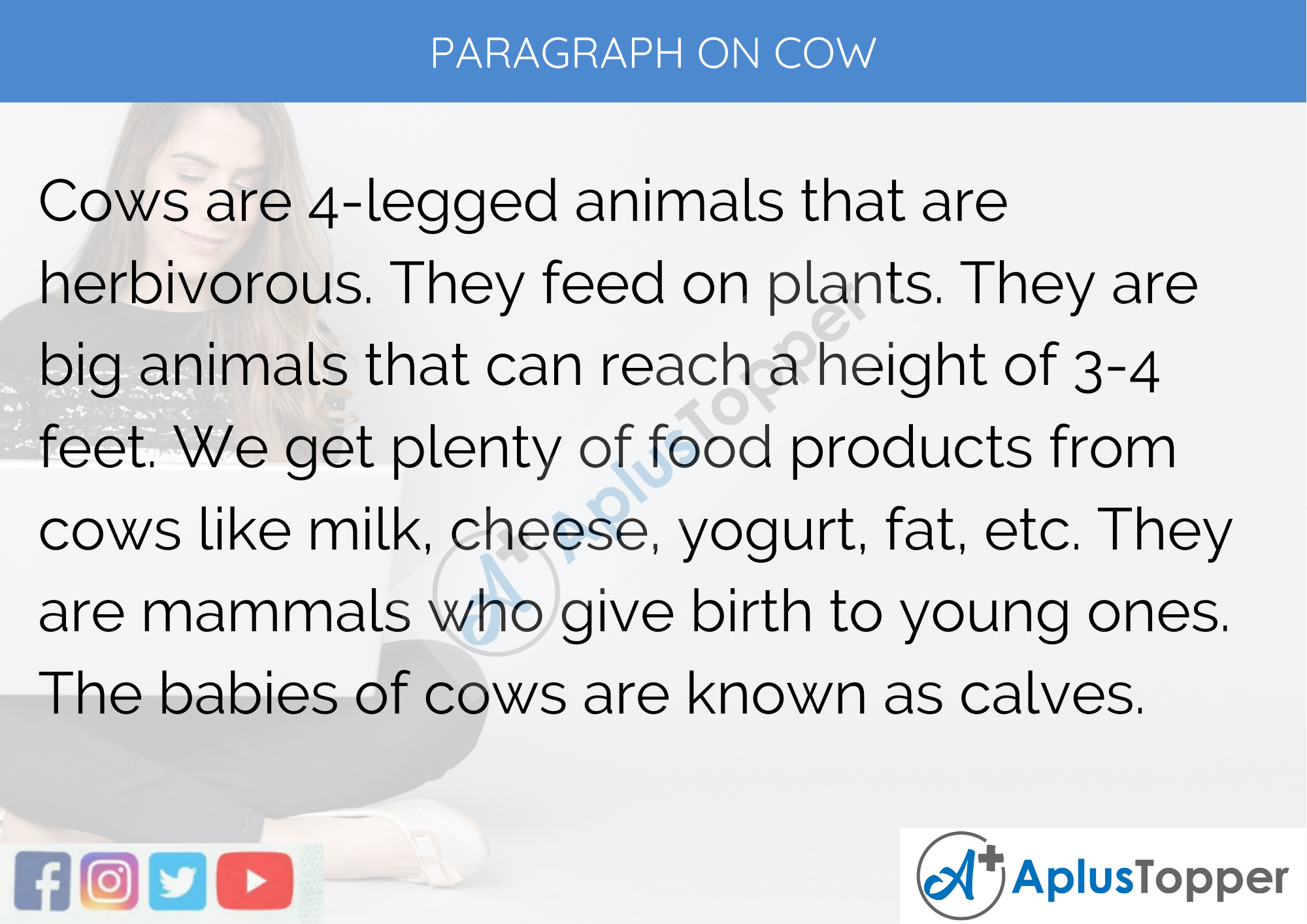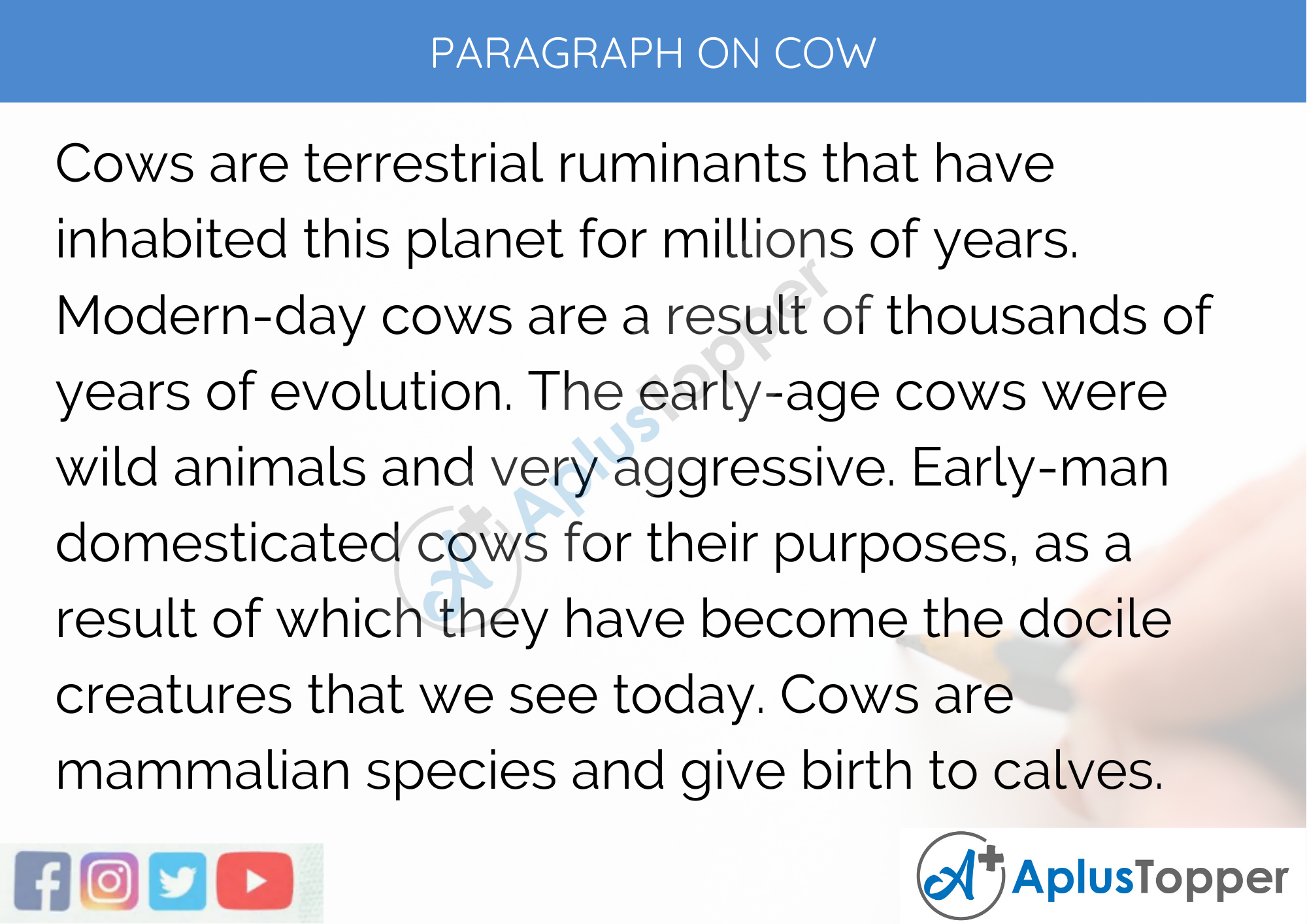Paragraph on Cow: Cows are one of the most important animals to man. They are categorized under livestock and help us in many ways. Cows are terrestrial mammals and feed on grasses and leaves. Man has been dependent on cows for many centuries for food, hide, and other products.
You can read more Paragraph Writing about articles, events, people, sports, technology many more.
Paragraph on Cow – 100 Words for Classes 1, 2, 3 Kids
Cows are 4-legged animals that are herbivorous. They feed on plants. They are big animals that can reach a height of 3-4 feet. We get plenty of food products from cows like milk, cheese, yogurt, fat, etc. They are mammals who give birth to young ones. The babies of cows are known as calves. There are many varieties of cows; some of them have white, plain skin, while others have a spotted body. Most of the cows have thick coats that are 4-layers deep. Cows are of great importance to man. We are dependent on them for plenty of products without which we cannot imagine our lives.

Paragraph on Cow – 150 Words for Classes 4, 5 Children
Cows are herbivorous animals that feed on grasses and plants. Their bodies are large, because of which they have enormous weights. To support this weight, cows’ legs have hooves that have been made secure due to keratin in them. This allows them to walk correctly. We need cows for many purposes like food, clothes, and cosmetics. In food, cows provide us with milk, cheese, butter, and meat. They are terrestrial mammals and give birth to young ones known as calves. Cows are diurnal animals and usually sleep at night. They have a great metabolism and require a lot of nutrition per day. The food of cows is referred to as fodder. Cows are kept in farms where they are needed for providing milk. These are sensitive animals and need a clean and dry place for staying. Plenty of large farms provide them with proper hygienic conditions to live in and take care of their nutrition.
Paragraph on Cow – 200 Words for Classes 6, 7, 8 Students
Few animals on earth are as important as cows. They have been tamed and used by man for thousands of years. We mainly depend on them for our food. In some countries, people use cow’s meat as a significant source of food. Cows are female cattle, and their male counterparts are known as a bull. They are domestic, bovine animals that feed on plants. The average size and color of a cow depending on its type of breed. There are many breeds of cows. Some of which are more popular like Jersey. The milk-producing capacity of cows is also dependent on its type of breed.
Larger cows produce more milk, but it is not always true. Cows have excellent grazing capabilities. Due to this, certain protected grasslands have been declared as anti-grazing zones. Adult cows have a set of 32 teeth. There are no upper-level incisors’ or canines in a mature cow. Their teeth have smooth surfaces with moon-shaped ridges that have been specially designed for an herbivorous lifestyle. Cows chew their food all the time. They can even take it out from their gut to chew it again properly.
Paragraph on Cow – 250 to 300 Words for Classes 9, 10, 11, 12, and Competitive Exams
Cows are terrestrial ruminants that have inhabited this planet for millions of years. Modern-day cows are a result of thousands of years of evolution. The early-age cows were wild animals and very aggressive. Early-man domesticated cows for their purposes, as a result of which they have become the docile creatures that we see today. Cows are mammalian species and give birth to calves.
The conventional scientific name of cows is ‘Bos taurus.’ A large variety of cow breeds can be found in every part of the world. They have been the most significant source of food for man. In some countries, like India, cows are regarded as sacred animals. Moreover, eating their meat is a criminal offense. Countries like the USA freely eat cow meat in the form of beef. The most impressive physical attribute of cows is the presence of a four-chambered stomach. Their stomach acts as a fermentation container.
The cellulose is broken down and assimilated into their bloodstreams. The tough plant fibers that they graze on cannot be digested at a single go. This is why cows regurgitate their food from the stomach and chew on them again to facilitate digestion. The food coming out of their stomach for regurgitation is known as cud. This helps in more excellent absorption of nutrients.
The regurgitation process allows cows to eat a lot of food within a short time, as they can always bring them back to their mouths for chewing. India, Brazil, and China have the largest cow populations on earth. They are responsible for the 1/3rd population of cows on earth. Cows have supposedly domesticated nearly 10000 years ago from the wild species of ‘aurochs.’ The continent of Eurasia is the place where cows originated from. The popular cow species of India is B. Taurus indices. It had a hum-back form. We are hugely dependent on cows for many food products. Even the cow dung and cow urine are used by man. Cow urine is widely used in perfumes as a popular base.

FAQ’s on Paragraph on Cow
Question 1.
When were cows domesticated?
Answer:
Cows domesticated 10000 years ago from the wild species’ aurochs’.
Question 2.
What do cows feed on?
Answer:
Cows feed on grasses, but while grazing, they also eat plenty of small insects.
Question 3.
What is the scientific name of cows?
Answer:
The scientific name of modern-day cows is Bos Taurus.
Question 4.
Why are cows important?
Answer:
Cows give us a lot of food products, from milk to cheese and butter; we are dependent on them for plenty of things. They are an inseparable part of our lives and are also of enormous importance to the ecosystem.
Question 5.
What is cow dung used for?
Answer:
Cow dung is used fuel in many rural parts of India. It is used in the form of dung cakes or is fermented to produce biogas.
